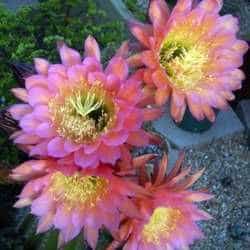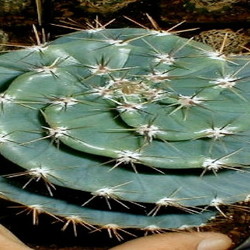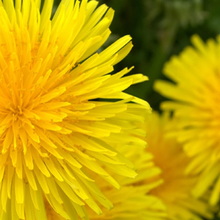(Editor's Note: This article was originally published on October 23, 2008. Your comments are welcome, but please be aware that authors of previously published articles may not be able to respond to your questins.)
I grow many different plants, and each new one I acquire seems like my new favorite plant. But after a time the newness wears off, and I sometimes don't notice the new plants anymore. I do notice plants that are spectacular and continually draw my eye to them, even if I have been looking at them for years. Many plants do this to me and often I get so distracted, I forget why I went out in the yard in the first place. Some of the top contenders for distraction are the blue cacti. They are distractive because they look so different and really stand out due to their unique colors; many of them are simply great looking and highly ornamental anyway.
There are many plants that have a bluish hue including aloes, agaves, palms, cycads and conifers. But none of them seem as blue as some of the blue cacti. And the great thing about the cacti is that they are so carefree and easy to take care of, requiring virtually no care except when a rare freeze comes in. Some of the bluer cacti seem to be the most cold-sensitive. All are sun-lovers and seem to be happiest when it's super hot and they are in full, blazing sun (not all cacti like this weather, but the blue ones sure do.)
 Pilosocereus sp. I found at a nursery; see how it stands out!
Pilosocereus sp. I found at a nursery; see how it stands out!
The following are some of the blue cacti I have some experience with. This barely scratches the surface of what is out there; I am not an expert on cacti, so I don't really know what I am missing.
Browningia. This is a relatively small genus of cacti from South America, with at least one spectacular blue species, Browningia hertlingianus (also known as Azureocereus hertlingianus.) It is also one of my favorite cacti in the yard and supposedly one of the more tender cactus species. This is a Peruvian species with knobby columns and golden spines to contrast with the powder blue to blue-green color. Mine has done fairly well during cold spells, but I have it against the house facing the afternoon sun, so that may have helped it survive the big freeze we had a few years ago.



(left) My own Browningia hertlingianus at purchase. (middle) Close up. (right) Needing support (notice where the tape has worn off the bloom showing a 'normal' green color underneath.)
Cereus. This is a huge genus of cacti, many which are blue or have a bluish cast--far too many for me to go into in this article, so I will just touch on a few of the more spectacular ones I have in my garden, and those seen at the local botanical gardens.
Cereus aethiops is a Brazilian species (so many blue cacti come from Brazil!) with ornamental jet-black spines and a knobby blue-green column. This is one of the more difficult species to manipulate in my garden as its long, thin, sharp black spines go right through my cactus gloves. But it's a nice looking plant in the landscape, though I understand it eventually becomes a gigantic sprawling monster and I will have to yank it out before it does. My Cereus aethiops has not had noticeable problems with cold.



(left) My own Cereus aethiops showing spines (new growth turns bluer with age.) (middle) In flower. (right) Crammed among other cacti and succulents in the garden; an exceptionally blue Agave tequiliana makes the Cereus look a lot less blue than it is.
Cereus hankeanus is another Brazilian blue species that has a good deal of ‘blue' to its skin color. It is a relatively thin and fast-growing columnar cactus. I have had to cut it back multiple times in the five years I have had this garden.

 Cereus hankeanus in my yard
Cereus hankeanus in my yard


(left) Flowers on Cereus hankeanus. (right) Plant is about 8 feet tall in just two years (not quite 2 feet tall when I acquired it.)
Cereus hildmannianus subsp. uruguayensis is another Brazilian species and one of the most commonly grown columnar cactus in the southwest, also known as Cereus pervuianus, or Queen of the Night. I had one growing in the yard, but it gets large too fast and is not terribly blue most of the time, so I got rid of it. I still have a few of the mini-monstrose versions of it, as they stay relatively small and tend to keep more of the blue coloration.



(left) At the Huntington. (middle and right) Two shots of my mini monstrose plants showing varying degrees of blue color
Ferocactus. Few think of Ferocactus as blue cacti, as most species are decidedly green. But Ferocactus glaucescens, as the name suggests, is a blue-green species, made even bluer by the contrast of the yellow-orange spines it spouts. It might be pushing the definition of 'blue' to say this is a blue cactus, but some are glaucous enough to look blue. Either way, it is one of my favorite cacti, so this gives me a chance to talk about it and show off some photos. This is a Mexican species and it does not tend to get enormous like so many of the other Ferocactus do, but eventually forms large, suckering colonies. Unlike some of the other blue cactus in my yard, this one is quite hardy (for southern California at least) and is one of the more carefree plants I own.



(left to right) Ferocactus glaucescens in a botanical garden, my own plant and flowers


(left) Ferocactus glaucescens f. nuda. (right) Normal (spiny) variety
Melocactus. Most Melocacti are green and known primarily for their amazing cephalums (the flowering portion of the cactus that sets on the barrel and forms a large reddish conical structure.) But at least two species, Melocactus azureus (a.k.a Turk's Cap) and Melocactus glaucescens (Waxy-stemmed Turk's Cap) have blue 'skin'. They are some of the most commonly available species, too; perhaps because of their color and also because they are among the hardier species. I have several of these in the yard; so far none have had any problem with low temperatures in the upper 20s F. Several internet sites list this species as hardy only to USDA Zone 11, but it is apparently hardier than that. These are very slow-growing plants, and mine have not grown appreciably in the years I have had them. Melocactus azureus has finer spines than Melocactus glaucescens, but otherwise I cannot tell them apart. Once the cephalum starts to appear, a Melocactus will stop growing and all further growth is put into the cephalum. I am hoping mine will keep growing for many years before the cephalum begins to form. The cephalum of these species is reportedly somewhat white, but all the ones I have seen have red tops. Like many of my favorite blue cacti, these are Brazilian species.

 My Melocactus glaucescens
My Melocactus glaucescens



(left) Melocactus azureus in a show. (middle) In the ground in California. (right) My own in a stone pot next to Ferocactus glaucescens f. nuda.
Micranthocereus. One species stands out in this genus, and it just happens to be the species I have in the yard: Micranthocereus estevesii (now the accepted name is Siccobaccatus insigniflorus.) If the blue Pilosocereus weren't already my favorite cacti, this one would be. It is such an intensely spiny cactus that the blue color is harder to appreciate, but the orange spines against the turquoise background makes for a truly ornamental plant. This, too, sadly is a very tender species and one of mine completely melted during that aforementioned freeze, while the other is still attempting to recover two years later.



(left) My Micranthocereus estevesii. (middle) In a show. (right) Another shot of my plant.

 Plant before and after freeze
Plant before and after freeze
Opuntia. This genus includes hundreds of species from all over the Americas. Most are green, but a few have a wonderful blue color. These are among the hardier cacti in existence, so there are no plants in this group I have to worry about their freezing to death. That does not mean I can't kill them, however; too little sun and they will rot.
Opuntia gosseliniana is a great-looking plant for the desert landscape, with deep turquoise pads and some shocking shades of purple and pink as well. This and the closely related Opuntia santa-rita (which some think is just a variety of Opuntia gosseliniana) are among the bluest of all the cacti. This is a fast-growing species, relative to most of the other blue ones mentioned so far; and a really bad plant to brush up against (itty bitty spines get in your skin and are hard to find.)



(left) Opunita gosseliniana in botanical garden. (middle and right) My own plant showing amazing color of new growth
 another bluish Opuntia labeled O. violescens in Huntington
another bluish Opuntia labeled O. violescens in Huntington
Pilosocereus. This is my favorite of all the blue cacti, primarily due to their availability, (some blue cacti are rare) extreme blue color and ornamental appearance. Some of these are so blue it is hard to believe a plant is really that color. On the other hand, there are plenty of Pilosocereus species that are not blue at all; I don't have any of them. For good photos and examples of each species, go to the columnar cactus web site. Pilosocereus is a genus that can be found in many South American countries, Mexico, the Caribbean and even Florida, but most of the really blue species seem to be from Brazil.



(left) Possibly Pilosocereus lanuginosus. (middle) Pilosocereus diersianus in a botanical garden. (right) Pilosocereus flexibilispinus


(left) Pilosocereus lanuginosus (tentative ID), in its first year. (right) Same plant two years later


(left) Unknown species with particularly turquoise coloration. (right) In another area of my garden; group of three are Pilosocereus pachycladus; others are unknown species.
Pilosocereus tend to be among the most tender of all the cacti I grow in the garden. All were badly damaged or killed last winter when it got down to 26F in the yard (it may have gotten a few degrees colder in spots.) Those that weren't killed had damage to the tips, but all have since grown new columns from just below the ugly scars. I have since learned that many growers place a wad of newspaper and a Styrofoam cup on the tops of their tender cacti when cold weather is coming; I will try that next time.


Pilosocereus pachycladus showing fresh cold damage, and older cold damage, with new growths showing up below damaged portion
So if you like the color blue and have the climate for cacti, these plants might make an interesting contribution to your landscaping or potted plant collection. Just be careful if it gets cold where you are (below freezing) and take measures to protect your plants; freeze damage never completely goes away.

















